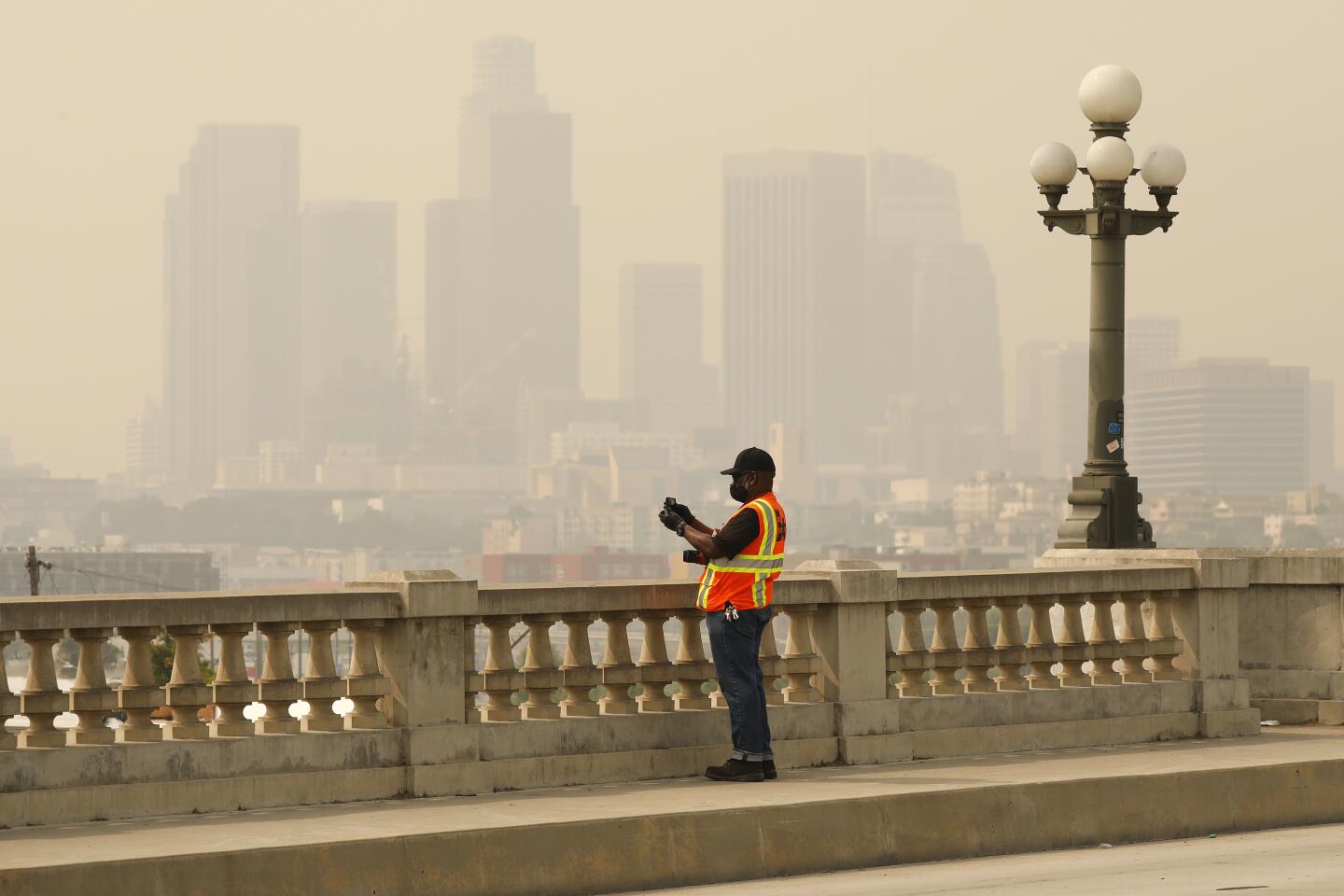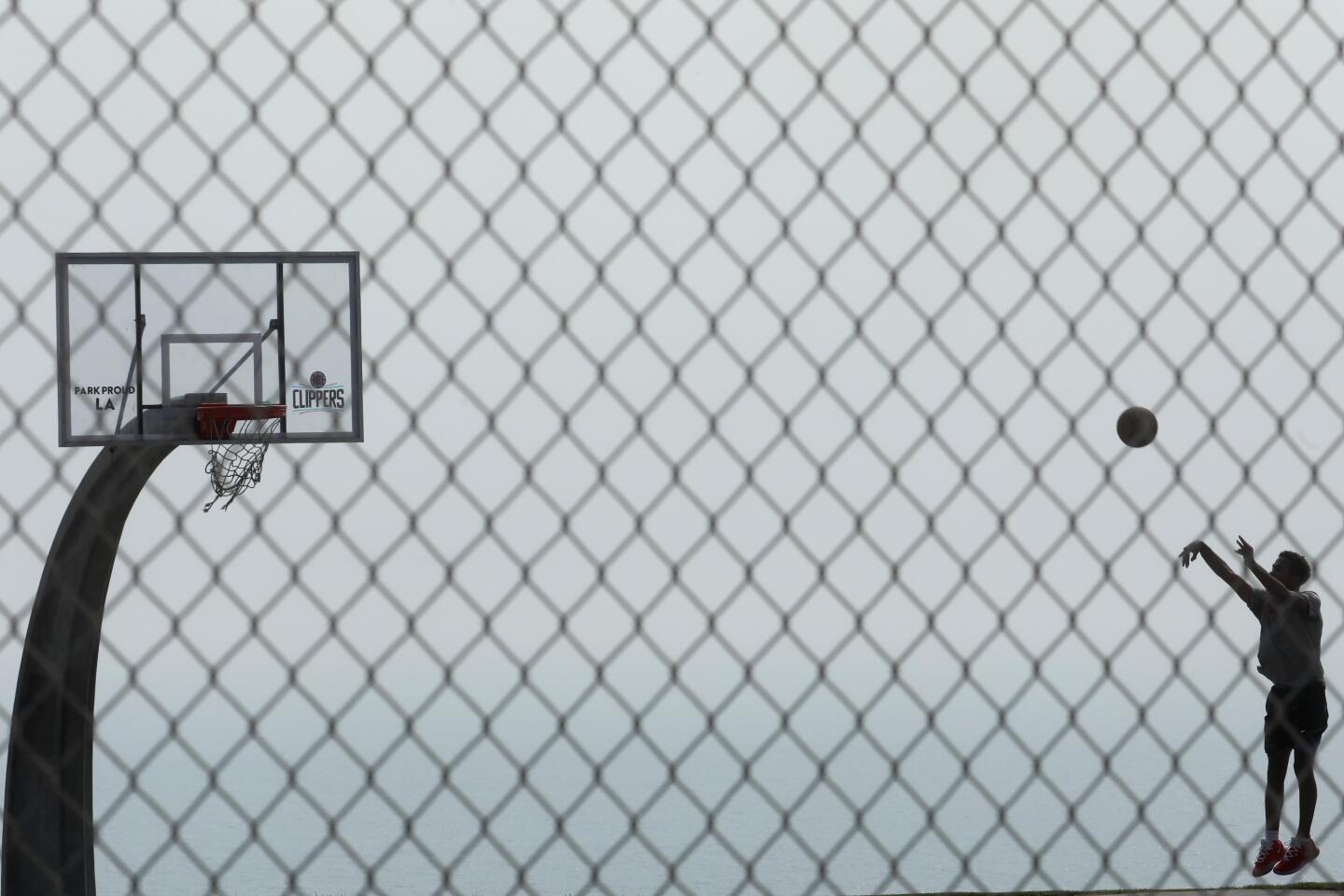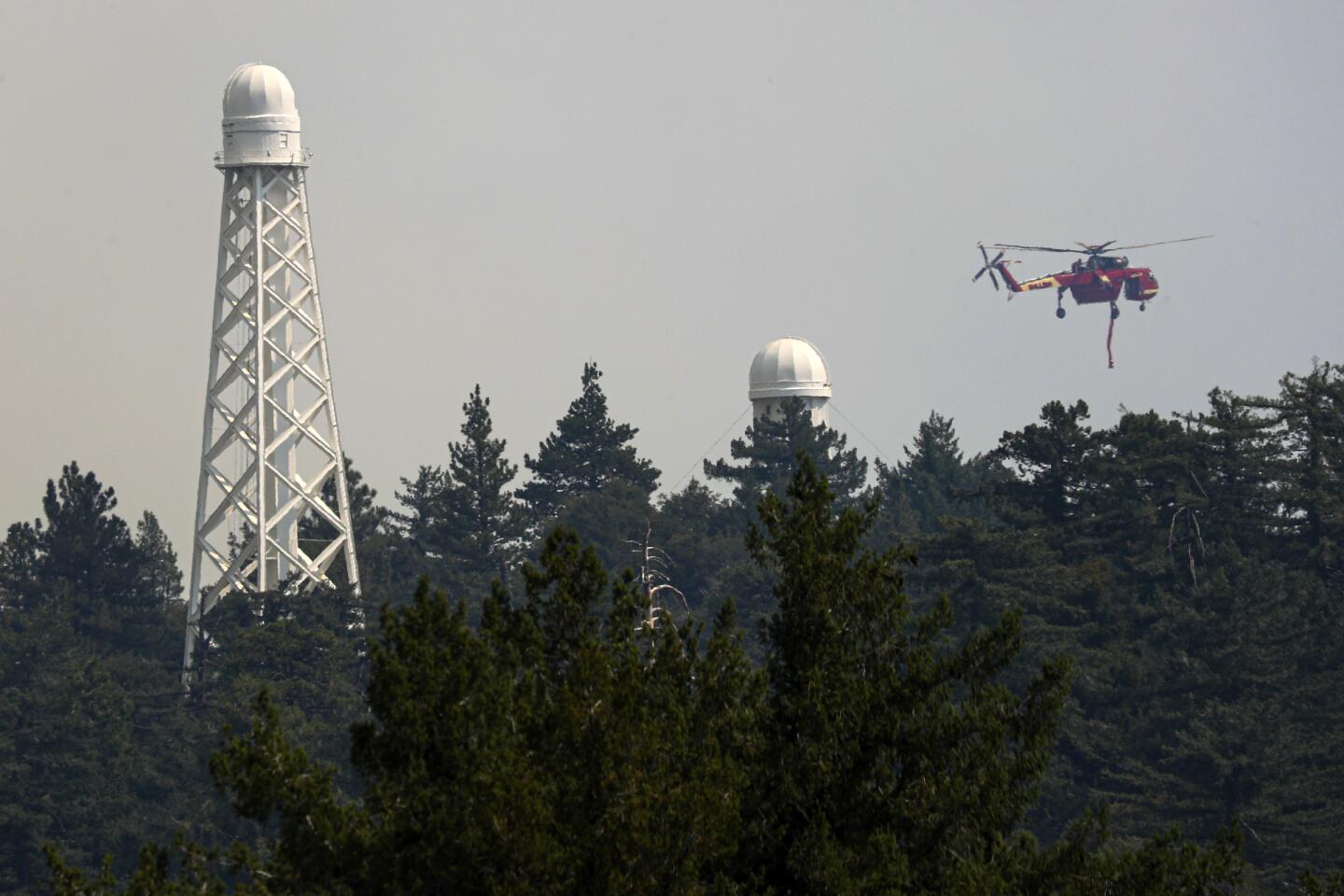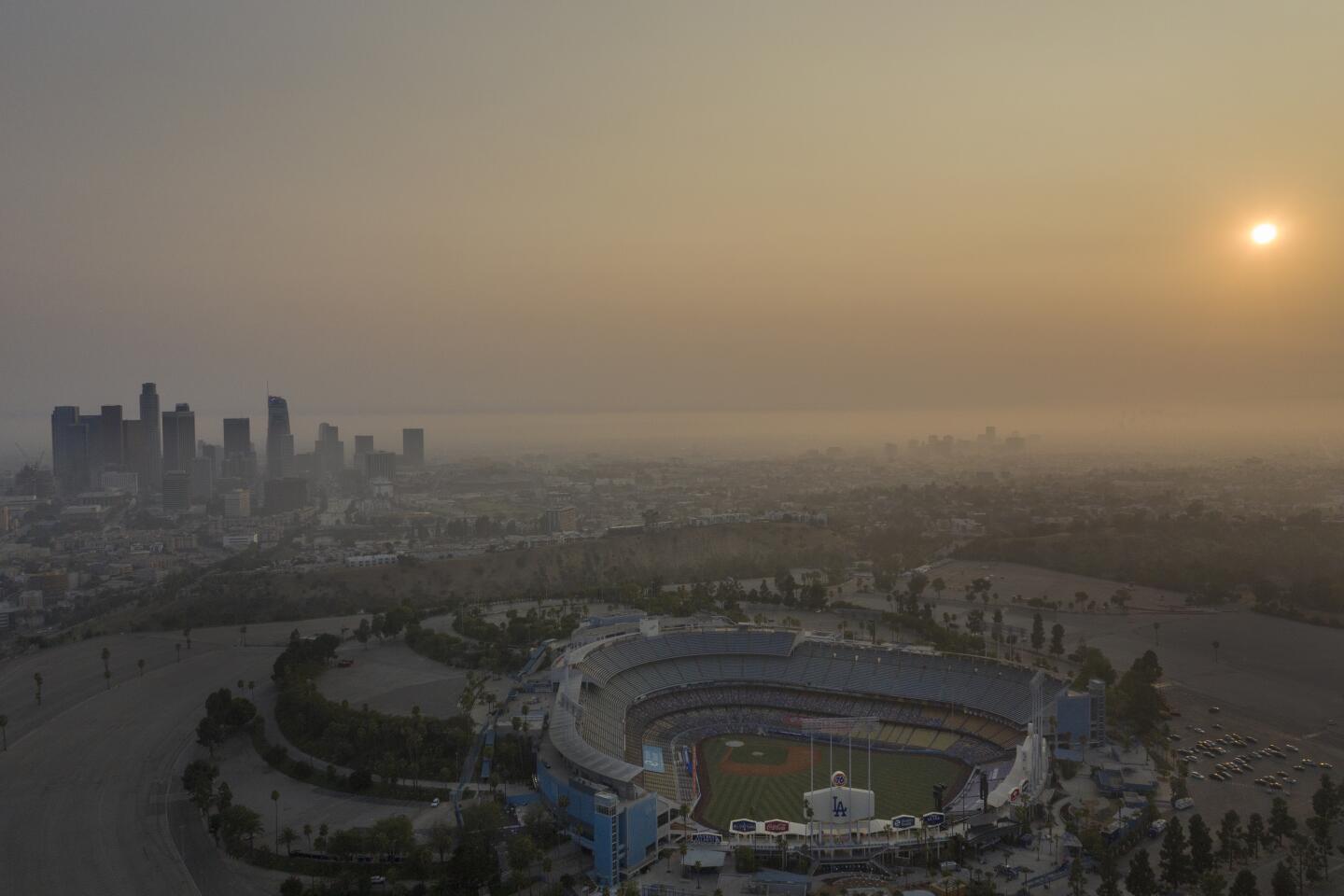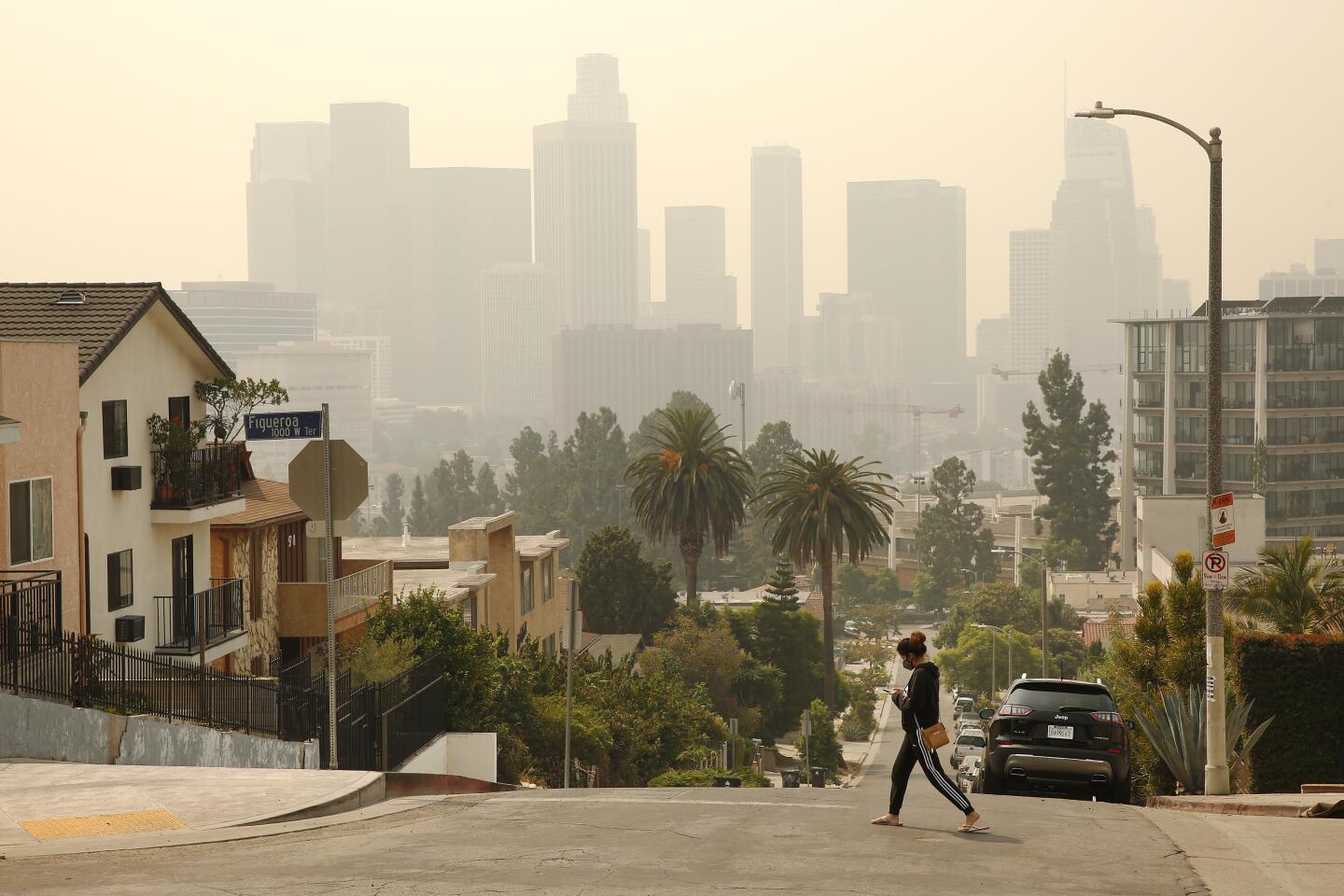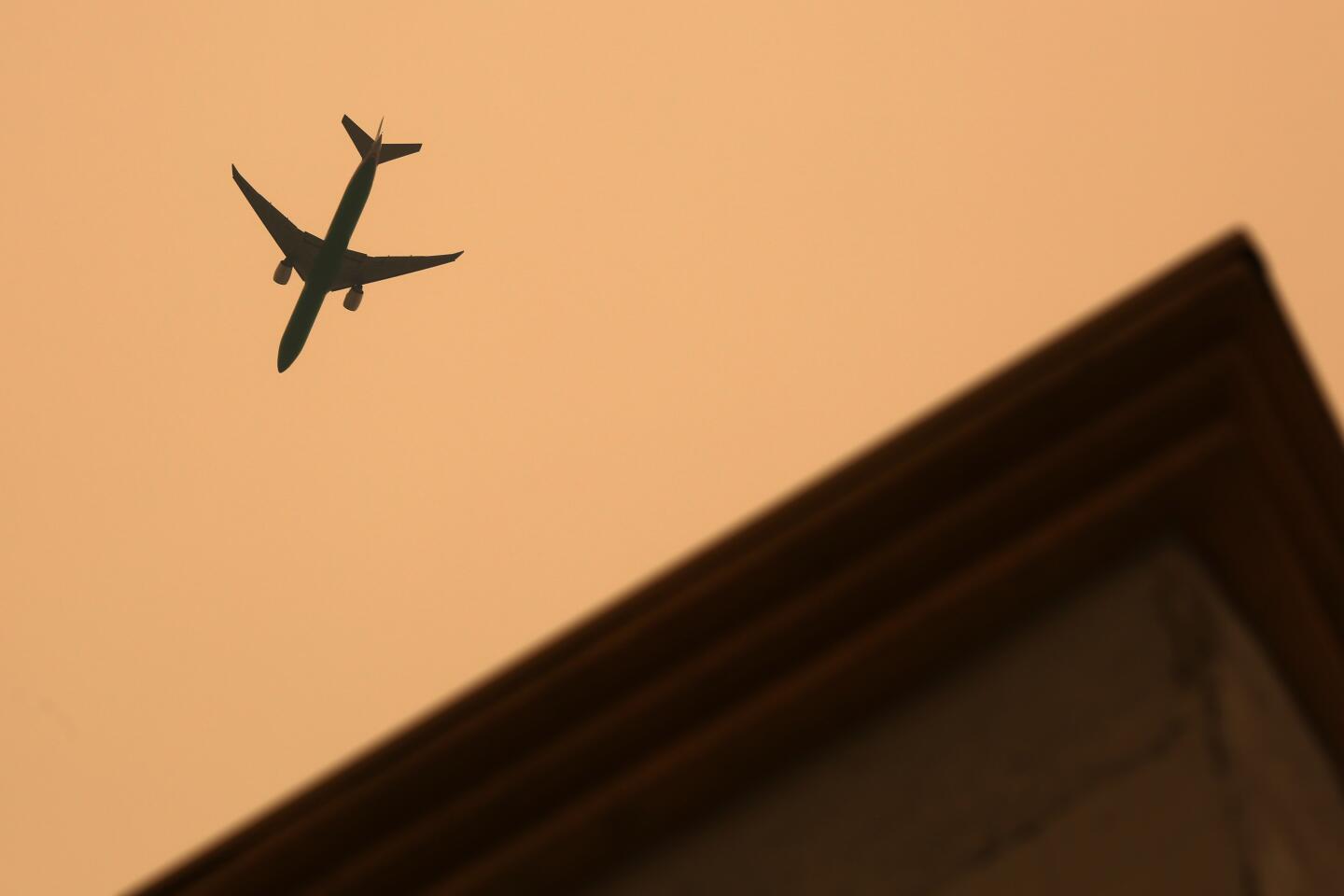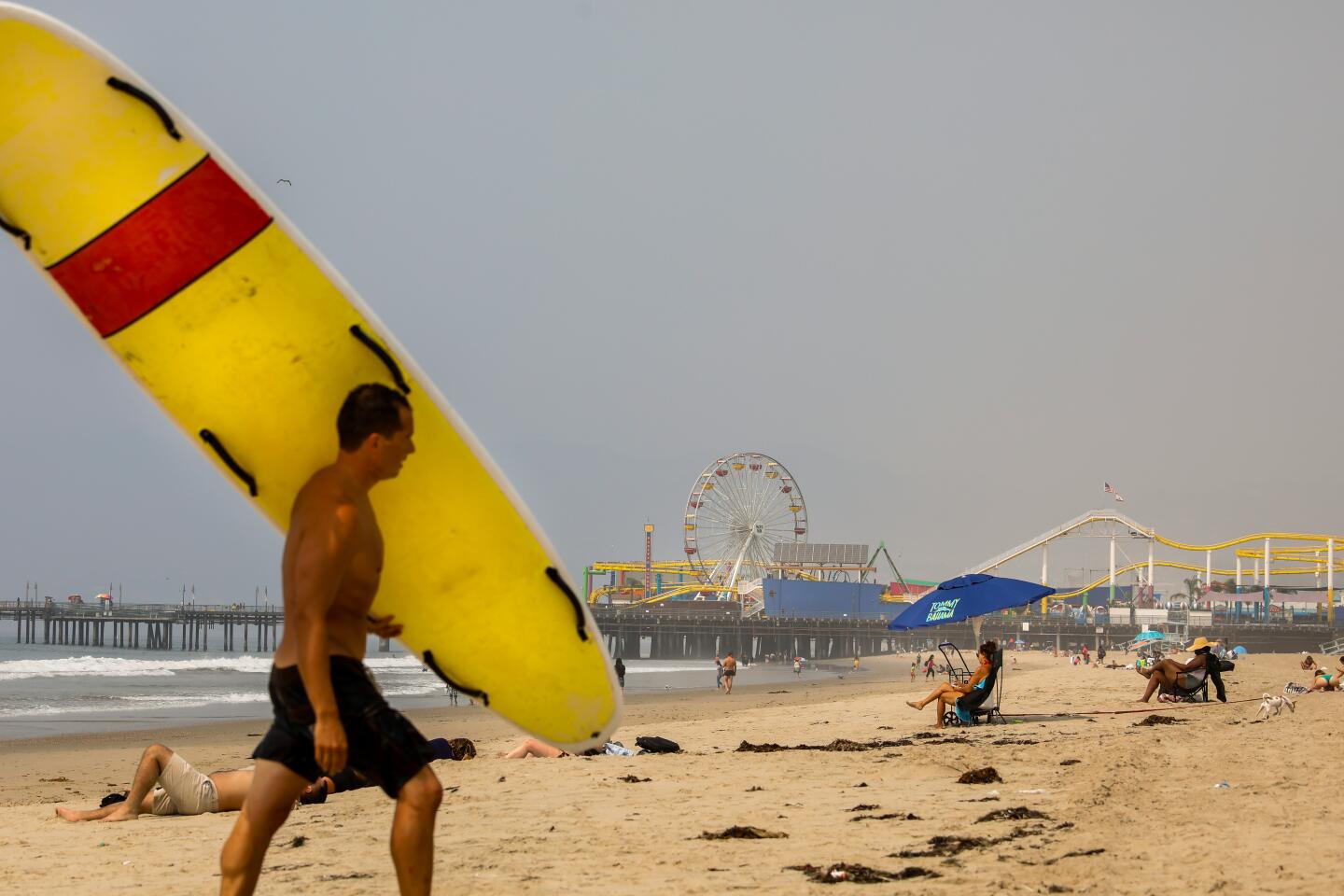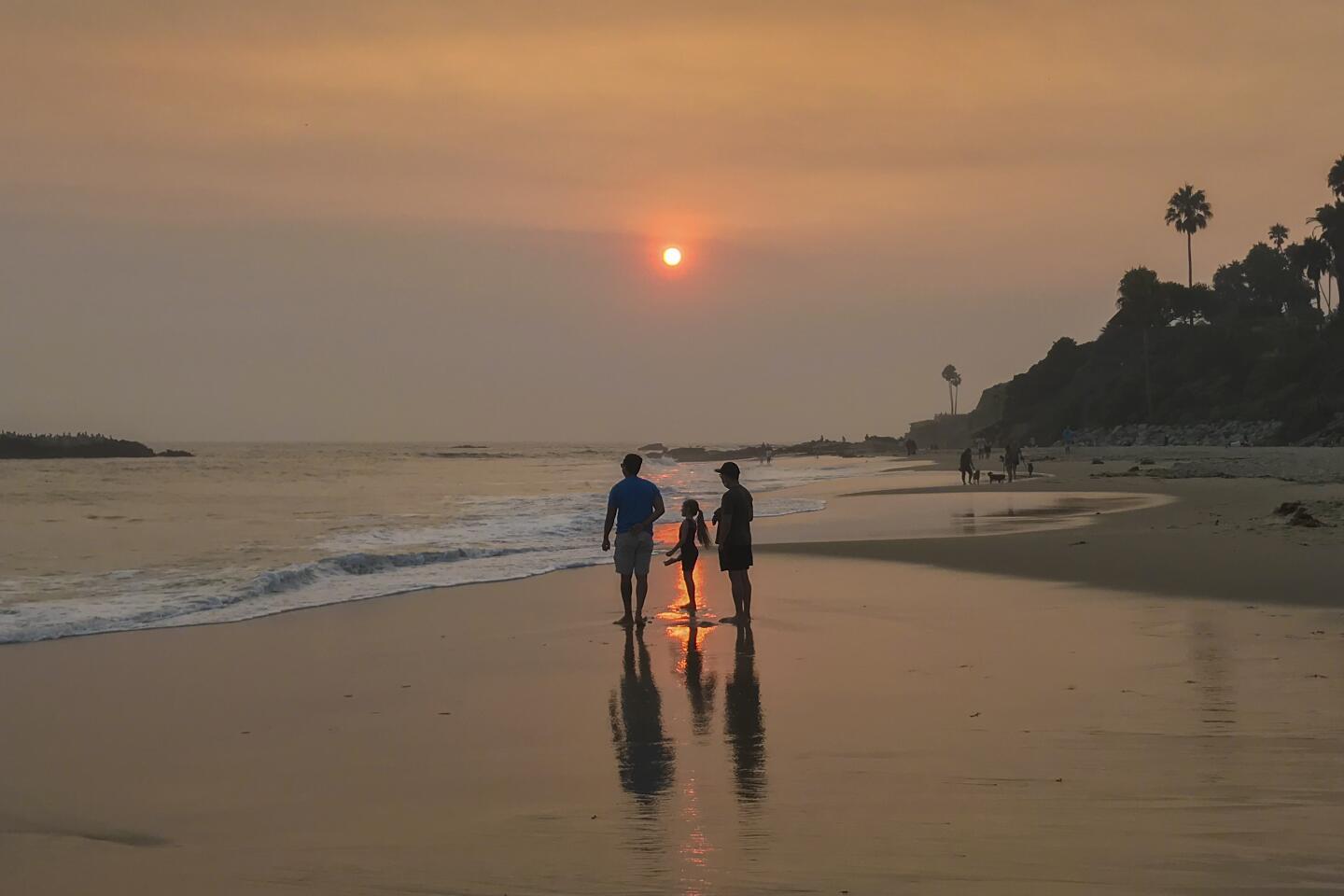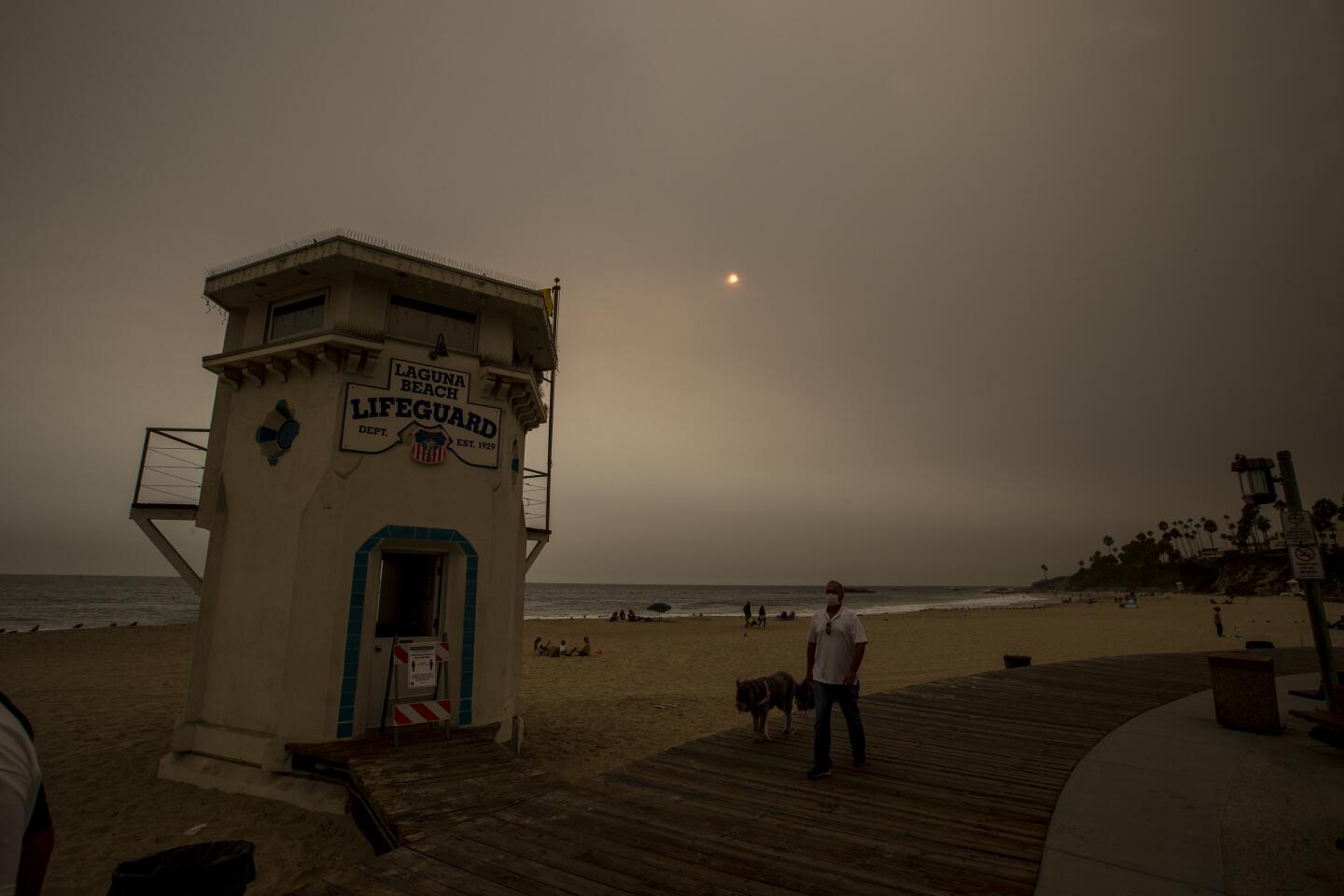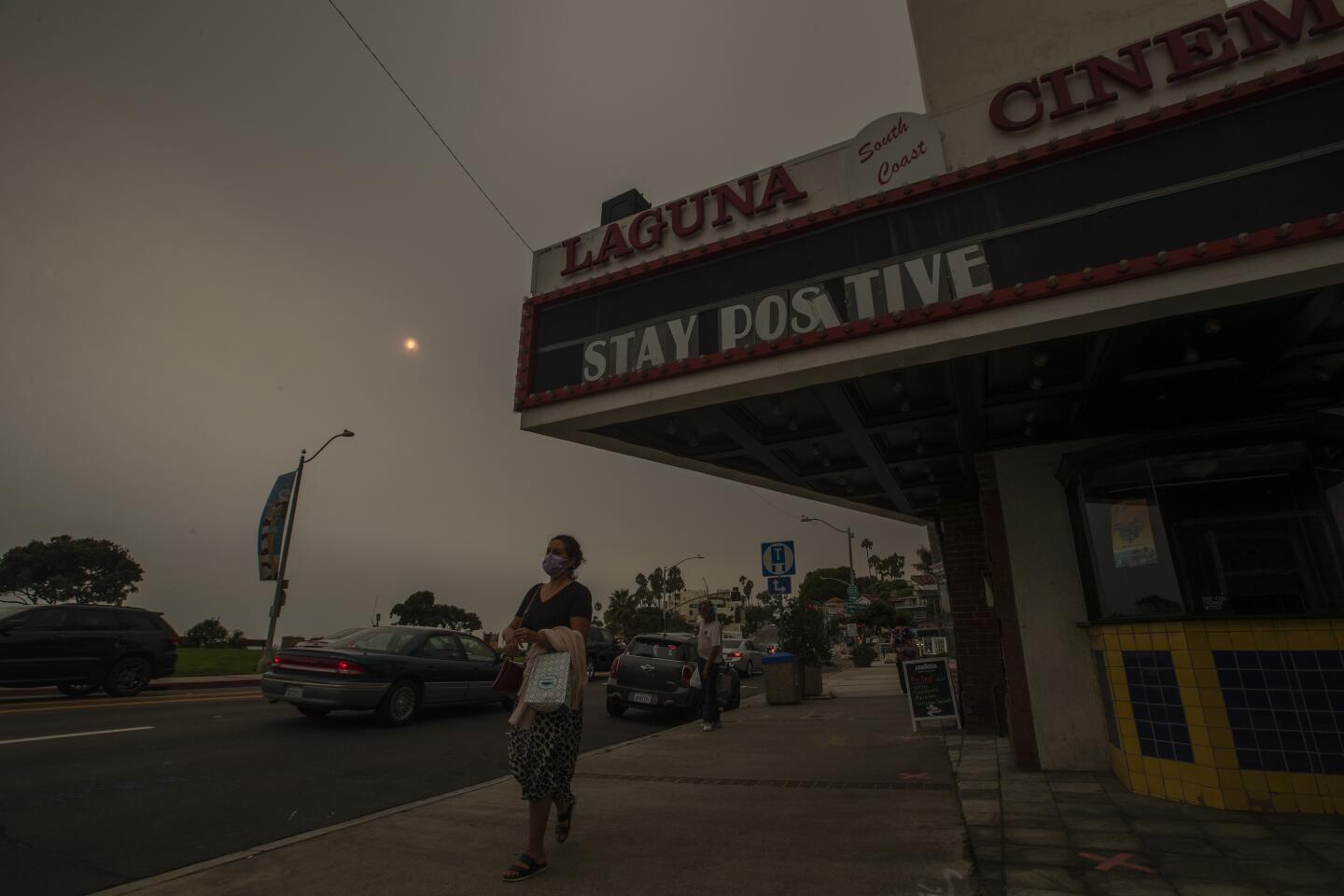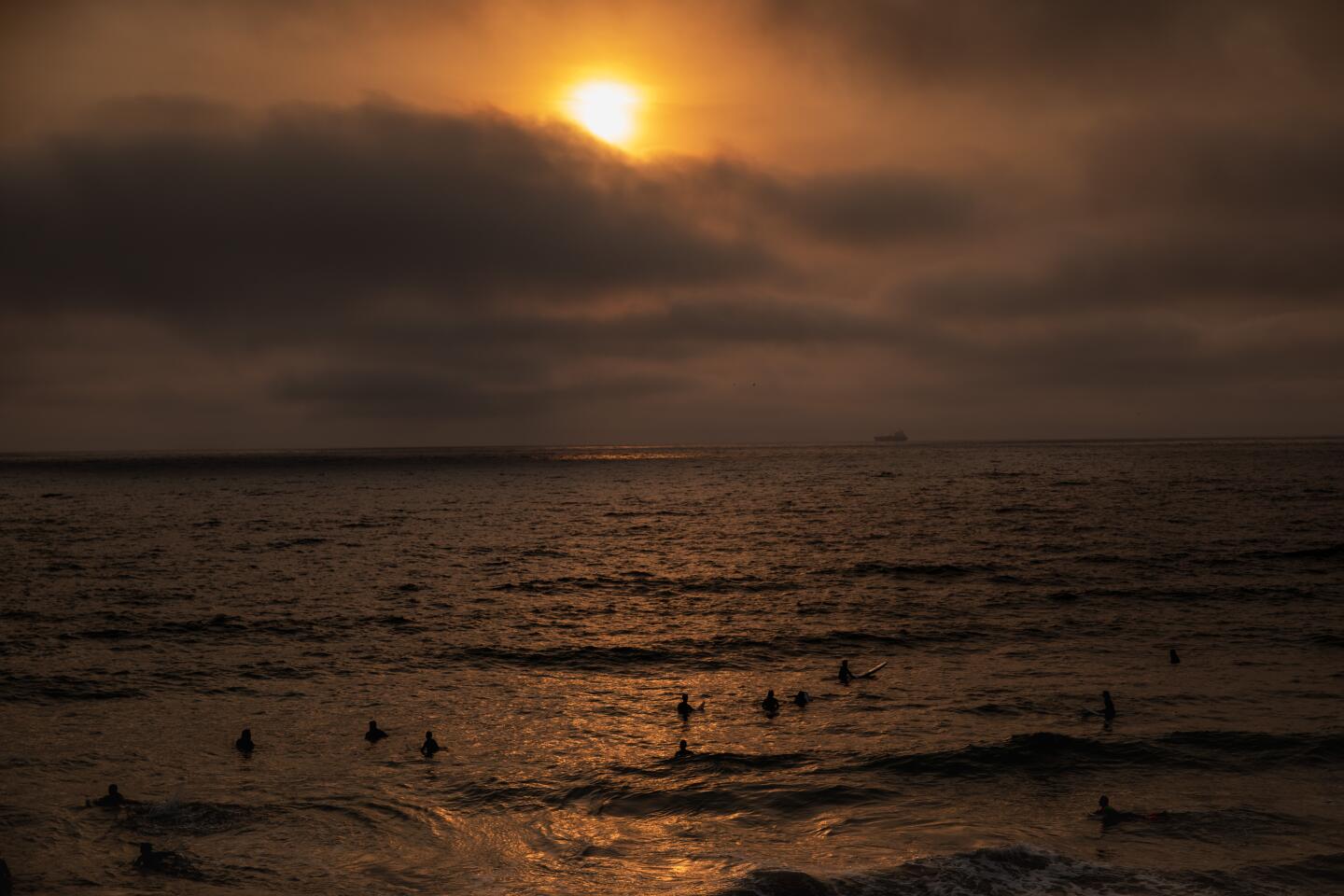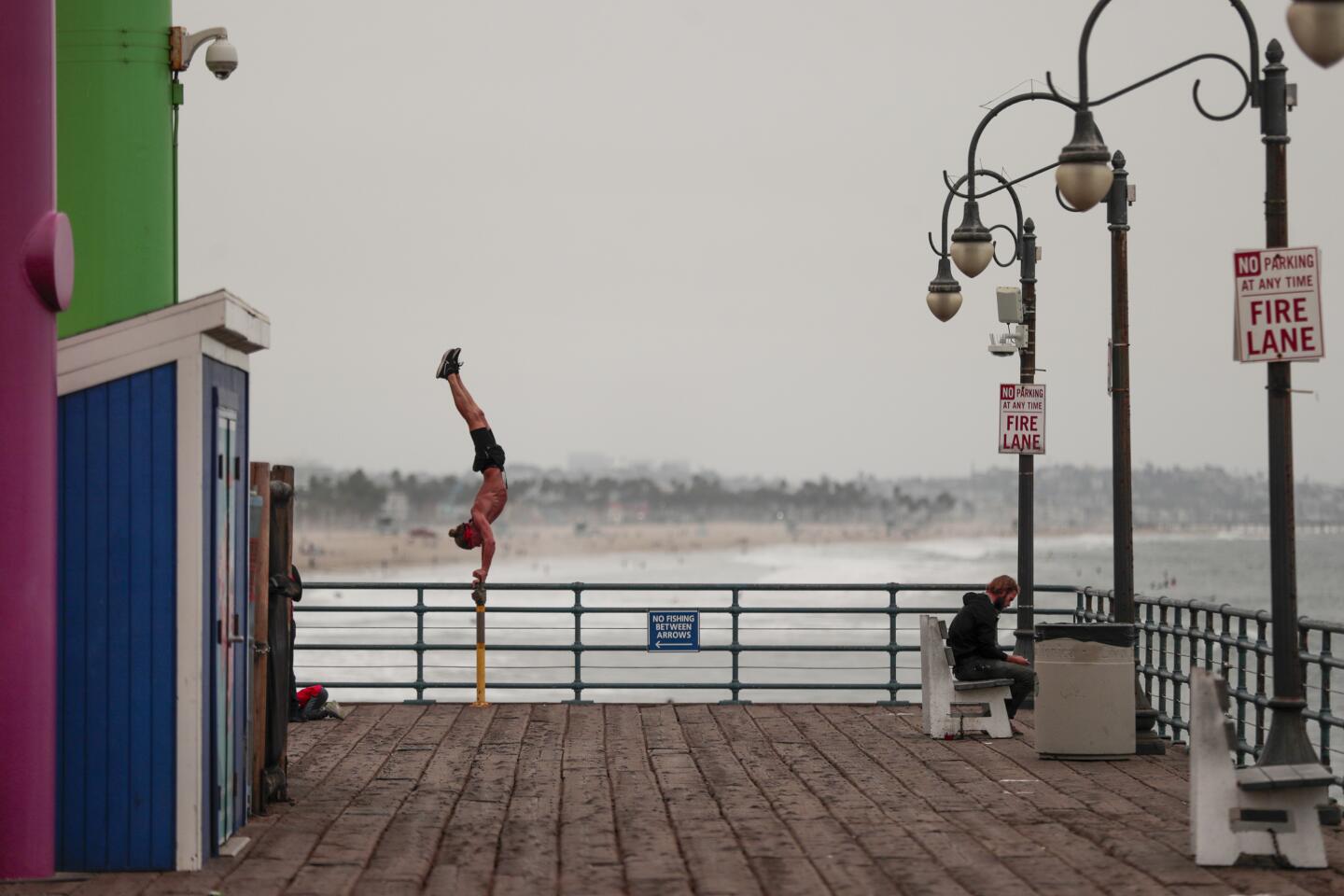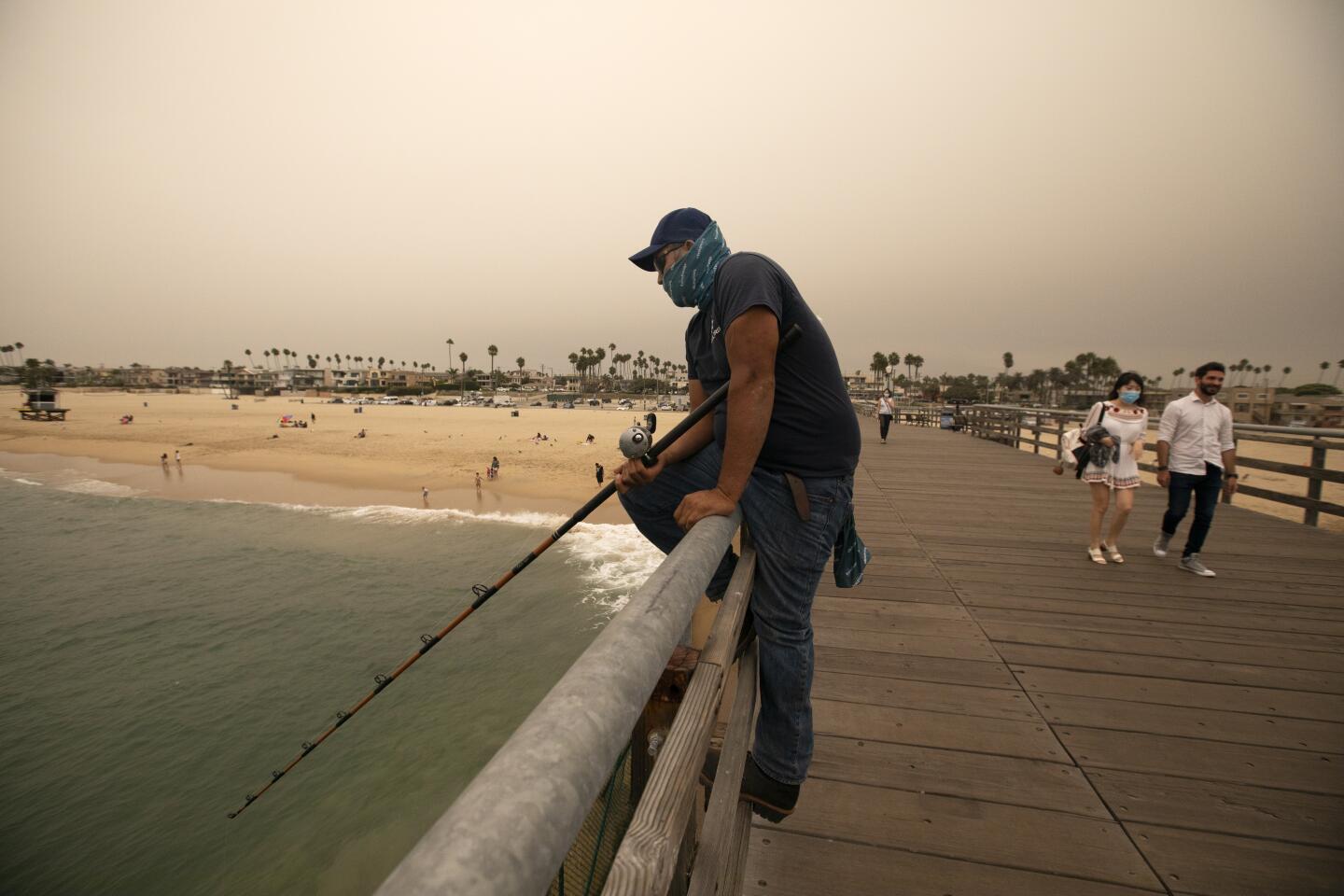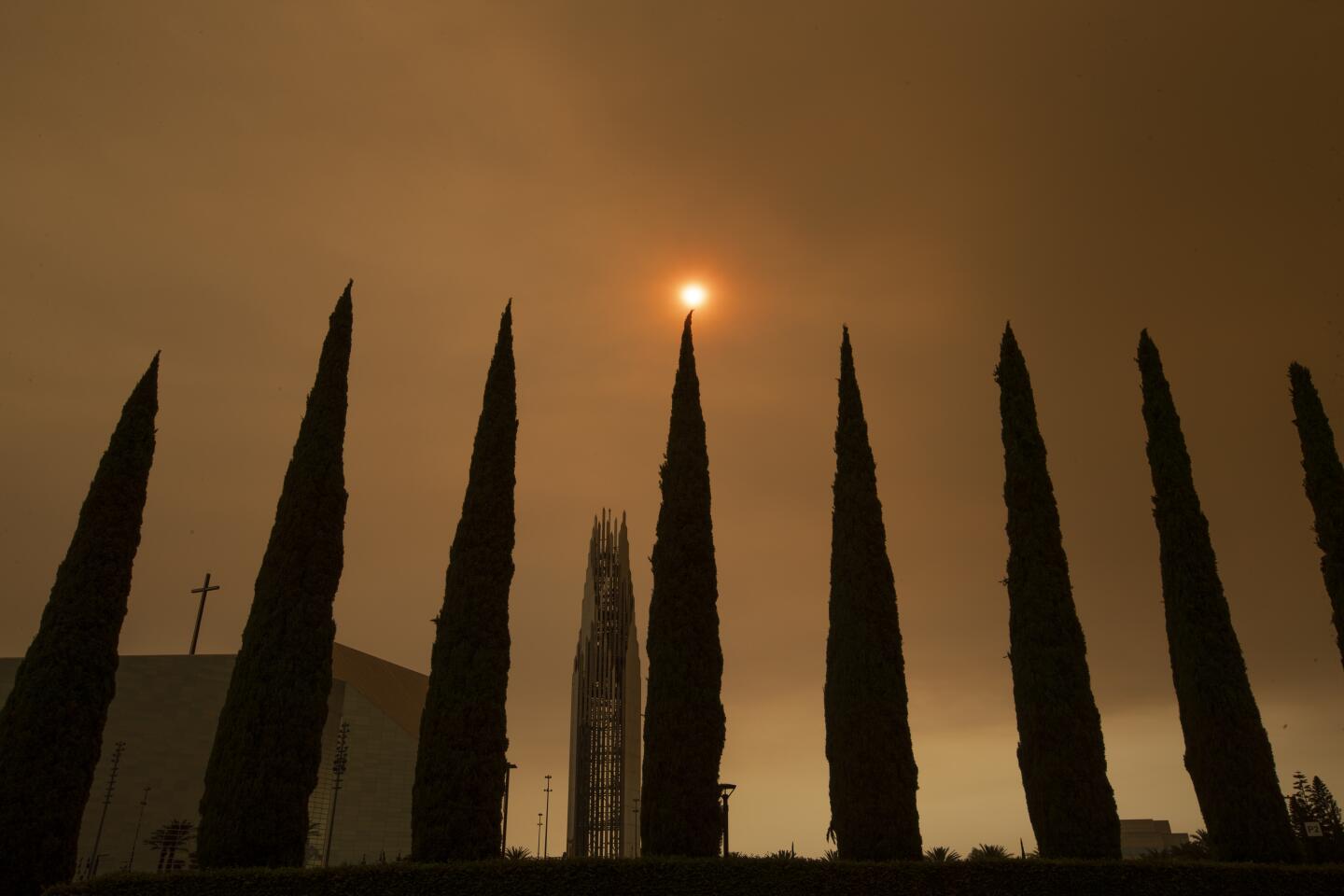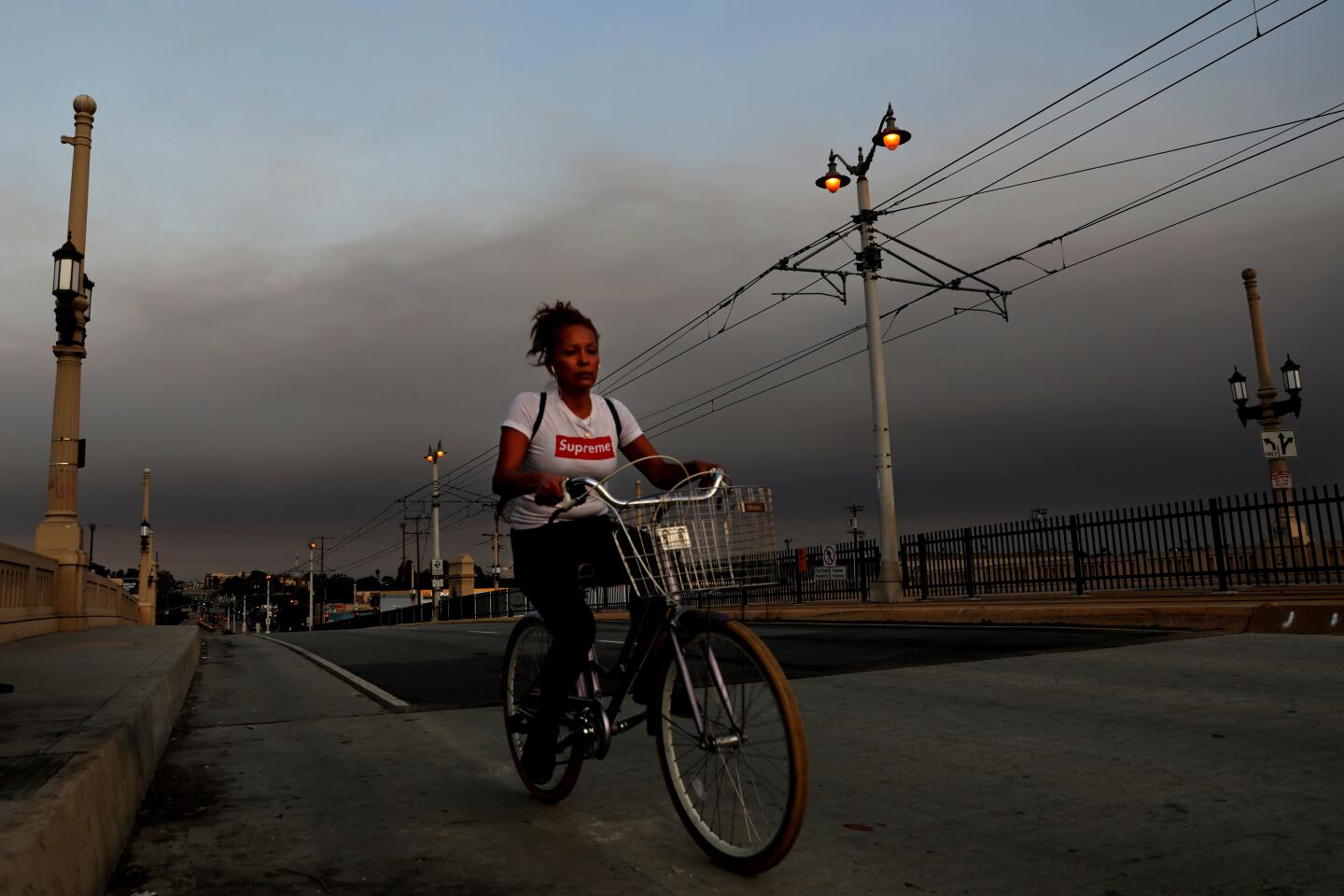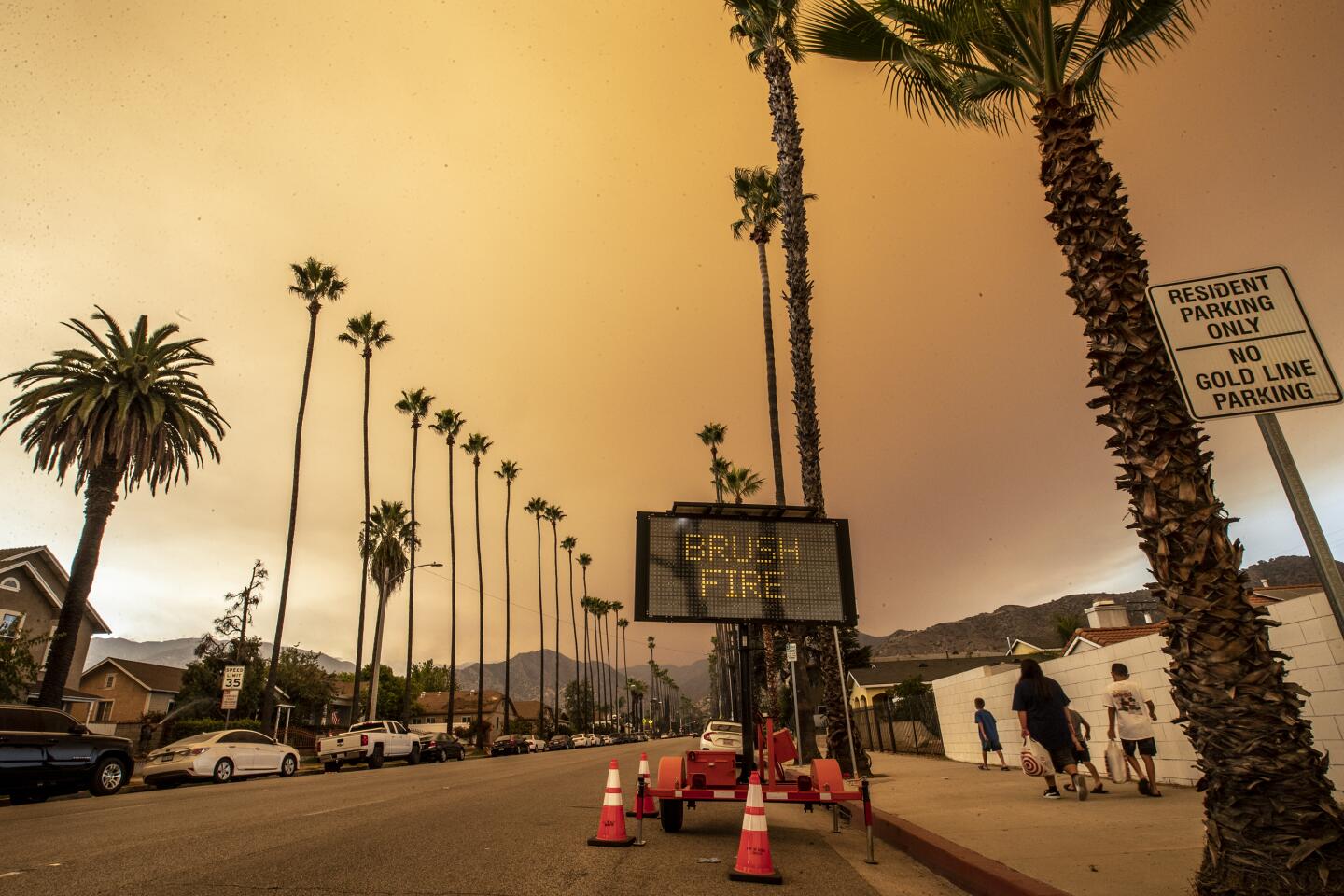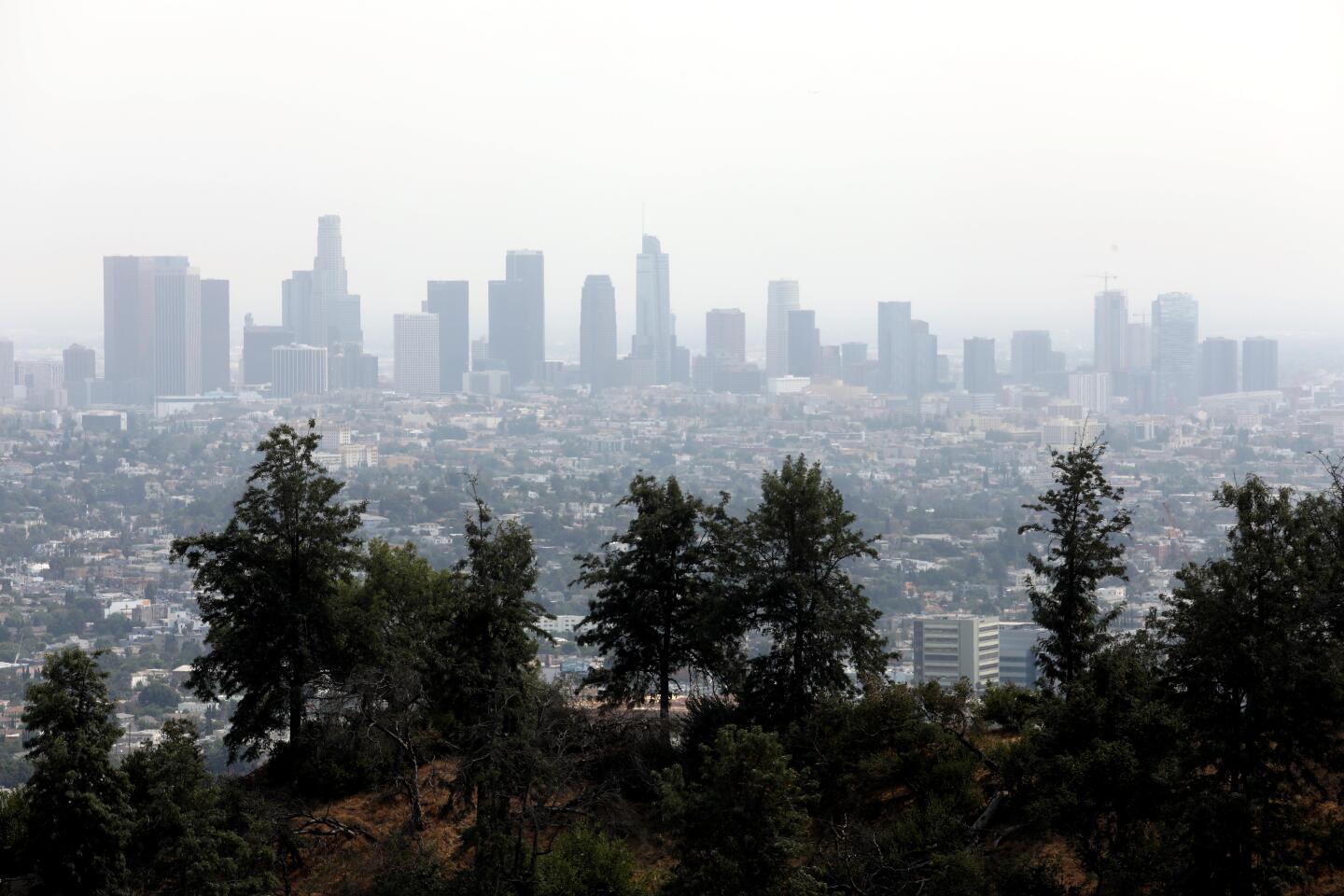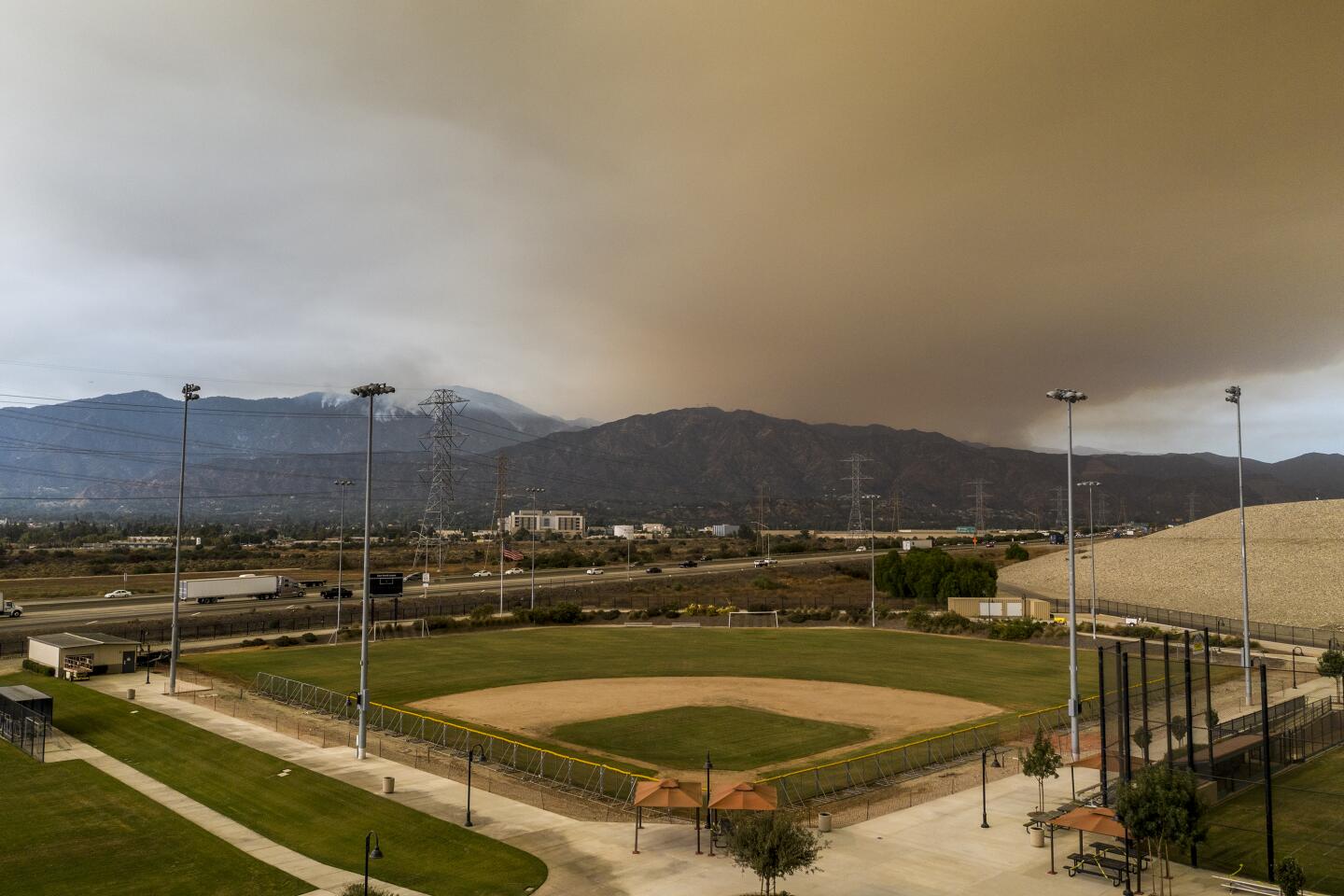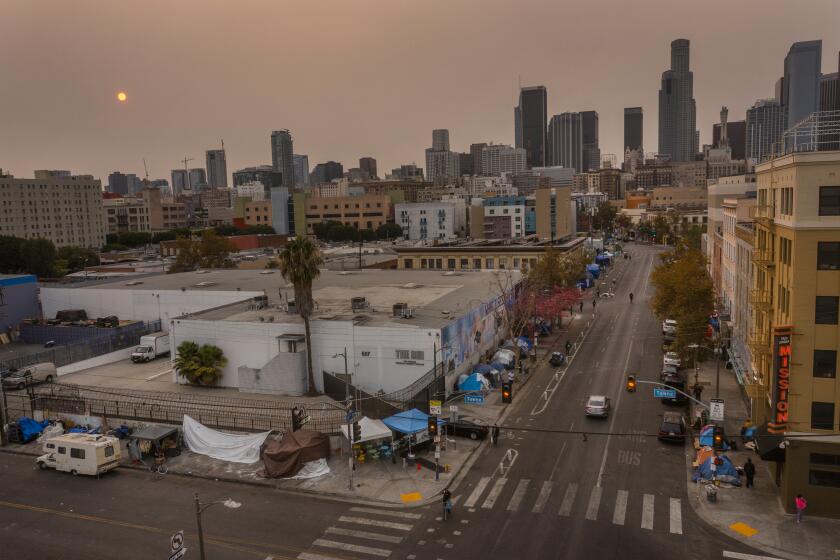Your questions about air quality answered
- Share via
Air quality in Southern California is at unhealthful levels because of wildfires close to home — the Bobcat and El Dorado fires — and all over California and the West Coast.
Experts recommend that you stay indoors and keep doors and windows closed. If you have one, run an air conditioner that recirculates indoor air and has a clean filter. Air purifiers can also help. You can make a DIY air filter out of a box fan, an air filter and duct tape (just be careful with it). Avoid strenuous physical activity, especially outdoors. People with lung conditions such as asthma, as well as the elderly and children, should take extra precautions.
Here are the answers to Times readers’ questions.
How can I check the air quality in my area?
If you live within the area covered by the South Coast Air Quality Management District — comprising most of Los Angeles, Riverside and San Bernardino counties and all of Orange County — you can use the AQMD’s air quality map. On Monday afternoon, areas near the Bobcat fire showed hazardous levels of pollution.
The website AirNow.gov lets you enter your ZIP Code and get the most recent air quality readings for your area, along with advisories on whether you need to reduce or avoid activities.
The L.A. County Public Health Department issues public health alerts about air quality and other topics. Orange, Riverside and San Bernardino counties do so as well.
The website Purple Air has a map that covers areas beyond the AQMD’s jurisdiction. Weather apps for smartphones have air quality readings too.
That orange or gray haze that Los Angeles residents are seeing is actually from wildfires burning more than 100 miles away.
What do the numbers on air quality maps and in weather apps mean? And what level is safe?
The air quality index readings you see from the South Coast AQMD are on a 500-point scale. Anything over 100 can be unhealthy for people with conditions such as asthma or heart disease. Anything over 150 is unhealthy for everyone, and people should limit outdoor activity when readings are that high. (Here’s a detailed explanation.)
Some weather apps, such as AccuWeather, use a different index. Plume Labs developed the one AccuWeather uses.
“Once you get above 101, even people without environmental sensitivities and existing respiratory illnesses will start to feel an impact,” said Tyler Knowlton, director of communications at Plume Labs.
Sometimes, different sources can have very different readings. For example, AccuWeather had a reading of 48, or “fair,” at noon on Monday. But the AQMD app and the native iPhone weather app showed readings of 157 and 159, in the unhealthy range for everyone.
If you can see or smell smoke, which many people in Southern California can, it’s a good idea to stay indoors as much as possible.
Here’s how to interpret the air quality numbers you see when you look at air quality maps or readouts on smartphone weather apps.
How protected are you from outside pollution when driving a car?
If your air conditioning is on and you press the car’s air recirculation button, which keeps the outside air from getting in, the air inside the car should be pretty clean, said Will Kaufman, content strategist at Edmunds.com.
Most cars purchased within the last decade will have an inside cabin air filter, which can filter the air over and over again as it’s recycled inside the car, he explained.
Luxury cars may even have an air ionizer feature, which imparts a slight electrical charge to particles so that it’s easier for them to stick onto the filter when the air is recirculated.
If your air filter is outside the car, then the air is filtered only one time before it circulates inside.
The Smart Air research team found that most car air filters were surprisingly effective, said founder Thomas Talhelm. He recommended turning the air conditioner on full blast for about a minute when you first get in the car and keeping it at a normal level for the rest of the drive.
If anyone is concerned about the quality of their cabin air filter, Kaufman recommends buying a HEPA (high-efficiency particulate air) filter for your car, which is easy to change yourself, he said.
Is there a way to find the exact current reading in my neighborhood?
No, there is no place to find up-to-the-minute air quality readings broken down by neighborhood. The closest thing is AirNow.gov, which will have the most recent available readings on the air quality in your ZIP Code.
The reader who asked this question was trying to determine whether exercise could be scheduled for lower-pollution times. But that is challenging to gauge. If the most recent reading says the air quality is unhealthy, it’s unlikely that it has meaningfully improved in the interim while the fires are still burning. Read on for more about exercise.
Is it unsafe to exercise outside?
Generally speaking, if you can see and smell smoke outdoors, “it’s probably not a good idea to be exercising outside,” said Ed Avol, a professor and chief of the Environmental Health Division in the Department of Preventive Medicine at the USC Keck School of Medicine.
There are short- and long-term risks to exerting yourself outside when the air quality is so poor. In the short term, you could deal with headaches, cough or throat or eye irritation. Those will typically resolve within a few hours or by the next day, Avol said. But in the long term, inhaling dangerous particulate matter increases your risk of developing diseases like chronic pulmonary obstructive disorder, asthma or cardiovascular problems.
As a lifelong runner, Avol said he understands the physical and mental health benefits of exercise that people are missing out on. Depending on your personal health and risk tolerance, he said, you could consider walking instead of running, shortening your run, skipping every other day or switching to an indoor workout for the time being.
Is there a generally safer time of day to exercise right now, like early in the morning?
Normally, yes. Right now, no. Avol said he usually tells people to avoid exercising on busy streets during rush hour or during the hottest part of the day. But smoke doesn’t have a rush hour or a down time.
“The problem is, with all the smoke, [air quality] doesn’t really change across the day,” Avol said. Exercising earlier or later in the day won’t make much of a difference.
Is it safer right now to exercise outside by the ocean?
Again: Normally, yes; right now, no. Usually, ocean winds blow pollution off the water and toward the city, so the beach is one of the cleanest places to breathe in L.A.
“Unfortunately, right now there’s no good outdoor solution” for exercising and avoiding poor air quality, Avol said.
Is it safe to exercise indoors, or should I try to avoid all exertion?
The air quality inside your house is likely better than outside of it right now, especially if you have air conditioning or another air filtration system and keep the doors and windows closed. Even if you don’t have air conditioning, Avol said, something as simple as keeping a damp towel over the cracks in doors and window sills will help improve your air quality.
To maintain better air quality in your home, consider making a DIY air filter. Don’t burn candles or incense, avoid using aerosol sprays, and turn on the induction fan on the stove when you cook.
Are the risks of poor air quality the same for pets as for people?
We received lots of questions about pets. Dr. Georges C. Benjamin, executive director of the American Public Health Assn., explained that animals’ respiratory systems are different from those of humans, but dogs, cats and, in particular, birds can be more sensitive to the poor air quality.
According to the Environmental Protection Agency’s “Protect Your Pets From Wildfire Smoke” fact sheet, the smoke can irritate your pets’ eyes and respiratory tract, especially if the pet has heart or lung disease.
The EPA recommends keeping pets indoors as much as you can. Call your veterinarian if you notice coughing or gagging, red or watery eyes, nasal discharge, inflammation of the throat or mouth, reluctance to eat hard foods, trouble breathing, fatigue, disorientation or reduced appetite or thirst.
“It’s not a good time for you and your pet to go for a run,” according to the fact sheet. “Let dogs and cats outside only for brief bathroom breaks if air quality alerts are in effect.”
“Keep them well-hydrated and, at a minimum, adhere to the same safety guidelines as humans,” Benjamin said. “Treat your dog like yourself.”
And that includes creating a “go bag” for your pets — an easy-to-carry emergency kit if you all need to evacuate.
What are the health effects on pregnant women?
“The first issue is the sensitivity they individually have to poor air quality,” Benjamin said. “The best thing to do is consult their doctor, because one’s underlying health conditions plays a big role.”
In general, the concern for pregnant women is that there is a correlation between poor air quality and smaller babies and early deliveries. Benjamin recommends pregnant women stay indoors and check the air quality index. If the AQI is over 150, they should try to minimize their risk by not having prolonged exposure to the air outdoors and not doing intense physical activity like running.
It’s like avoiding smoking and secondhand smoke, he said.
At what point should one evacuate because of poor air quality?
We received several questions about this. Many people don’t have the option of leaving, but if you have the option, should you?
It’s a tough question to answer, said Benjamin, because everyone’s situation is different. But here’s what he tells his patients.
“First, look at the fire risk. And then, from an air quality perspective, if you’re in any of the sensitive groups, and if the air quality is projected to be unhealthy, 150 or higher, for a few days, and you can’t protect yourself at home, you might consider leaving.
“It’s about weighing your options. What resources do I have to stay here? Is it safe for me to stay here? If you have asthma and your asthma is flaring up, you have to make a decision about whether you can go someplace else for a little while, and it might be easier to leave sooner rather than later. But if you can protect yourself inside, then maybe you can tough it out for a few days.”
He gives this as a general guideline: With an AQI of 150 to 200, try to avoid any outside activity, including mowing grass or other heavy physical exertion. Over 200, any kind of physical activity outside is not healthy. Over 300, avoid going out until it’s safer.
How does the smoke affect our safety when it comes to COVID-19?
“There’s evidence that air pollution exacerbates the lining of your lungs and causes more inflammation, and that inflammation makes it easier for COVID-19 to infect your lungs, so you could get sicker if you are exposed,” Benjamin said. “Now, those are early studies, from the last few months, but that tends to be pretty clear.”
Can masks help mitigate the effects of this air pollution?
We received several variations of this question.
“You need a really good mask to protect against pollution,” said Knowlton of Plume Labs.
“You can imagine that a particle small enough to pass through the membrane of the lungs into our bloodstreams has no problem penetrating even the best cloth mask,” he added.
For tiny pollutants, according to a 2016 University of Massachusetts Amherst study, cloth masks may offer only 40% to 65% protection — better than nothing if one must go outside. And Talhelm of Smart Air pointed to data on the effectiveness of surgical masks.
“However, there is a risk that these masks will impart a false sense of security in the wearer, in particular in these extreme pollution situations,” Knowlton said.
Knowlton recommended N95 and anti-pollution masks. But the situation is even more complicated as we’re in the midst of a pandemic. Anti-pollution masks commonly have valves to let air out and make breathing easier.
“Unfortunately, valves render the mask pretty much useless in preventing the transmission of viruses, because it is designed to let air out, along with whatever else might be in that air,” Knowlton said.
What do I need to know about running an air conditioner?
Questions about air conditioners were common. When and how to run an air conditioner depends on the type of unit and its filter. AQMD recommends running air conditioners that recirculate indoor air and have clean filters.
Window and wall units, for example, draw air in from outside, cooling it in the process. The unit then vents back out into the world. Most of them have some sort of filter (there are many kinds), which catches varying degrees of pollutants in the process of pulling outside air inside.
In a wildfire situation, the air in your home is very likely to be cleaner than the air outside. So Knowlton said that if you are going to be drawing dirty air in with an air conditioner, you’ll want to be confident the type of filter you have can effectively screen the most harmful pollutants.
Does being by the beach help our air quality any during this time?
This question comes from Angel La Canfora in Torrance. Unfortunately, living by the beach doesn’t offer any special protections from wildfire smoke, said Romain Lacombe of Plume Labs, which builds global maps of air quality levels for AccuWeather.
Knowlton of Plume Labs added: “There’s also the distance from busy streets that could help, as well as a lack of tall buildings making corridors that can trap pollution. However, in wildfire circumstances, the situation is so radical and the plume of smoke so big, the normal gains from local winds and proximity to other sources of pollution are virtually obliterated.”
Air quality readings bear that out. On Friday afternoon, there wasn’t much difference between Torrance and downtown Los Angeles, for example.
What is the weather phenomenon trapping the smoke over the Bay Area, and when will it get better?
Brian Garcia, a meteorologist with the National Weather Service in the San Francisco Bay Area, said the smoke is essentially trapping itself. Here’s how he explained it.
We’re all familiar with the onshore winds, or sea breezes, that tend to pick up in the afternoons in San Francisco (and in Southern California, for that matter). That generally happens because inland areas are warmed by the sun, causing warm air to rise and creating low pressure. The air over the ocean typically has higher pressure, so that air rushes to the lower-pressure areas inland: sea breeze.
But smoke from wildfires has drifted over the Bay Area and is blocking the sun, preventing inland areas from heating up and disrupting the normal pattern of onshore winds. So the air close to the ground where we breathe is not being mixed or moved around as much as it normally would be.
The other way for air to mix and move around is for a storm to act like a “broom and sweep the whole thing clean,” Garcia said.
As for when things might get better, last week, Garcia had hoped that a storm moving toward the Pacific Northwest would come far enough south on Sunday to push some smoky air out of the Bay Area. That didn’t happen — air quality readings were still in the unhealthy zone Monday afternoon. Another storm could be headed for Northern California by the end of this week.
Does air quality get better at night?
This question comes from Dan Sucher in Highland Park. And the answer is: Not really. Garcia said that in conditions like those we have now, air quality can actually worsen at night. There tends to be less wind at night, and that allows pollutants, such as smoke, to settle closer to the ground.
How long is this terrible air quality going to last? Is there any relief on the horizon?
Light onshore winds picked up in Southern California on Monday. And that means some areas could see slightly thinned-out smoke, and others will get thicker smoke, Kathy Hoxsie, meteorologist with the National Weather Service in Oxnard, told The Times on Monday. She added that no big change is expected until at least the middle of the week.
“We have that big high pressure over us, and as long as that’s there, it’s kind of a cap on the smoke,” she said.
The South Coast Air Quality Management District has forecast moderate to unhealthful air for a large swath of the region, including central Los Angeles and the San Gabriel and San Fernando valleys. Conditions are expected to be somewhat better along the coast and in Orange County.
California’s wildfires have left many Southern California gardens dusted with ash. That coating can hurt the plant’s ability to soak in the sun, but a quick rinse with a hose will send the ash into the soil, where it can actually do some good.
What can I do about ash?
The AQMD recommends the following:
- Don’t clean up ash and soot if you have heart or lung problems.
- Don’t let ash get on your skin.
- Don’t use leaf blowers to clear ash. Use a damp cloth or a light spray of water.
- Direct any ashy water to ground areas and away from runoff systems.
- If you have ash in your home, use a vacuum with HEPA filters. Sweep gently if using a broom.
- Wash your car and any toys or outdoor furniture.
- Clean ash off your pets.
